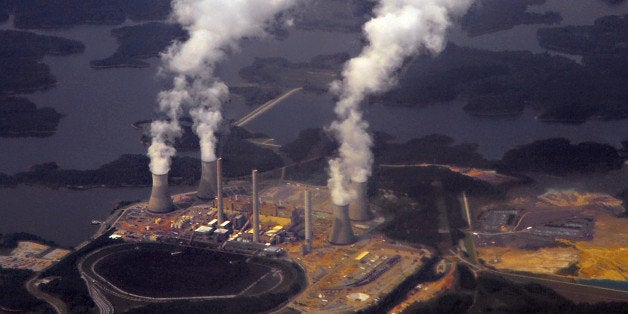
WASHINGTON -- While the Supreme Court's Monday ruling on mercury standards was a setback for the Obama administration's drive to regulate emissions from power plants, it's not necessarily a death blow for the rules.
Environmental advocates say they have two reasons to be hopeful: The lower court could still allow the rules for mercury and air toxics to go forward while the Environmental Protection Agency readjusts them in response to the Supreme Court's decision, and the decision doesn't necessarily have negative implications for the rest of the administration's sweeping power plant standards.
"We could have gotten hosed, and we didn't," said John Walke, a senior attorney at the Natural Resources Defense Council. "This decision was just about as narrow as it could be."
The Supreme Court's decision found that the EPA had failed to properly consider the costs of compliance when it issued regulations on the emission of mercury and air toxics from power plants. The court's liberal justices, in their dissent, argued that the EPA had considered costs -- just not at the initial stage of determining whether to regulate the emissions in the first place.
The decision sends the case back to the D.C. Circuit Court, which will decide whether to throw the rules out or allow them to stand while the EPA determines a path to come into compliance with the Supreme Court's directive. In the meantime, the rules -- which already took effect earlier this year -- stay in place.
"The ruling did not say the rule itself was flawed," said Graham McCahan, a senior attorney with the Environmental Defense Fund. Instead, he argued, there's a strong case that the rules should be allowed to stand while the EPA conducts additional accounting of the costs and benefits of compliance at the behest of the court.
Bill Snape, senior counsel with the Center for Biological Diversity, was also confident that the regulations would not be thrown out entirely. "I think one could make the prediction that the rule not only will stay in place for the foreseeable future, it may stay in place forever," he said.
In some ways, the case for regulating mercury emissions has gotten stronger in the nearly four years since EPA first released the mercury and air toxics rules, environmental groups argued. The industry groups and states that challenged the mercury rule highlighted $9.6 billion in anticipated compliance costs, while the EPA argued that the benefits of avoiding mercury and other emissions would be at least triple that.
But a number of power companies already working toward compliance have found that the costs of doing so are lower than they originally projected. In response, it's possible the EPA could come back with additional cost-benefit analyses that build their case for the reductions. The EPA also estimates that 70 percent of plants affected by the mercury rules have already come into compliance.
Critics of the EPA regulations were more inclined to see the Supreme Court decision as a fatal blow, projecting that the circuit court would likely block the restrictions if the EPA has to reassess the upfront costs.
"How can you leave step two in place if you are saying you have to go back to step one, presumably?" said William Yeatman, a fellow at the Competitive Enterprise Institute.
Many have also wondered what Monday's decision, written by Justice Antonin Scalia, means for the larger portfolio of rules that the Obama administration has enacted as part of its drive to clean up power plants. The biggest piece of that puzzle is the EPA's Clean Power Plan, which aims to address greenhouse gas emissions from both new and existing power plants in an effort to help stop global climate change.
The agency issued draft rules in June 2014, and is expected to finalize them in the coming weeks. The rules are widely expected to face legal challenges once they are finalized. (Coal companies and 14 states rules have already challenged the rules, but a federal court threw out that suit earlier this month, arguing that it was premature since the rules haven't even been finalized yet.)
Conservatives in Congress who have long protested the Obama administration's push to regulate power plants celebrated the mercury decision as a cautionary tale for other rules. "EPA’s actions have far-reaching consequences, even when they are the result of unauthorized actions," said Sen. Jim Inhofe (R-Okla.), chair of the Environment and Public Works Committee, in a statement. "The Courts must keep this in mind as the agency approaches finalization of its so-called Clean Power Plan.”
Environmental advocates said they don't think the mercury decision will have a direct influence on those rules, since the greenhouse gas standards were issued under a different section of the Clean Air Act and are meant to address different pollutants, and Monday's decision deals with a very specific portion of the law. The Competitive Enterprise Institute's Yeatman also said he didn't see many implications for other pollution-control policies.
But the Center for Biological Diversity's Snape said one takeaway is the role of Justice Anthony Kennedy, the deciding vote in the mercury case and a number of other key environmental cases. "I think one of the reasons Scalia's opinion here is so constrained [is] that's the only way he could get Kennedy," he said.
Others saw wider implications for how this particular court approaches environmental cases. "The majority of the Supreme Court is clearly very skeptical of EPA's regulatory authority. You see that again and again in recent environmental decisions," said Jacob Hollinger, an attorney with McDermott Will & Emery LLP who previously worked with Clean Air Act cases at the EPA's New York office. He noted that the EPA will likely have to defend its interpretations of the various parts of the Clean Air Act under which the Clean Power Plan was constructed.
"That should be worrying for EPA," he said.

